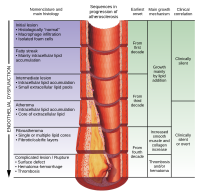
Photo from wikipedia
It is well established that overstretch of arteries alters their mechanics and compromises their function. However, the underlying structural mechanisms behind these changes are poorly understood. Utilizing a recently developed… Click to show full abstract
It is well established that overstretch of arteries alters their mechanics and compromises their function. However, the underlying structural mechanisms behind these changes are poorly understood. Utilizing a recently developed collagen hybridizing peptide (CHP), we demonstrate that a single mechanical overstretch of an artery produces molecular-level unfolding of collagen. In addition, imaging and quantification of CHP binding revealed that overstretch produces damage (unfolding) among fibers aligned with the direction of loading, that damage increases with overstretch severity, and that the onset of this damage is closely associated with tissue yielding. These findings held true for both axial and circumferential loading directions. Our results are the first to identify stretch-induced molecular damage to collagen in blood vessels. Furthermore, our approach is advantageous over existing methods of collagen damage detection as it is non-destructive, readily visualized, and objectively quantified. This work opens the door to revealing additional structure-function relationships in arteries. We anticipate that this approach can be used to better understand arterial damage in clinically relevant settings such as angioplasty and vascular trauma. Furthermore, CHP can be a tool for the development of microstructurally-based constitutive models and experimentally validated computational models of arterial damage and damage propagation across physical scales. STATEMENT OF SIGNIFICANCE Arteries play a critical role by carrying oxygen and essential nutrients throughout the body. However, trauma to the head and neck, as well as surgical interventions, can overstretch arteries and alter their mechanics. In order to better understand the cause of these changes, we employ a novel collagen hybridizing peptide (CHP) to study collagen damage in overstretched arteries. Our approach is unique in that we go beyond the fiber- and fibril-level and characterize molecular-level disruption. In addition, we image and quantify fluorescently-labeled CHP to reveal a new structure-property relationship in arterial damage. We anticipate that our approach can be used to better understand arterial damage in clinically relevant settings such as angioplasty and vascular trauma.
Journal Title: Acta biomaterialia
Year Published: 2018
Link to full text (if available)
Share on Social Media: Sign Up to like & get
recommendations!